|
|
Spearmint

|
|
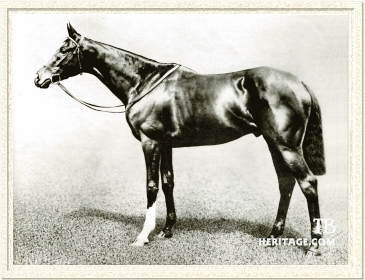 |
|
|
When the mighty Australian champion Carbine left his homeland aboard the liner Orizaba on April 13, 1895 to start a new phase of his stud career in Great Britain, those thousands who saw him off and those who greeted him upon his arrival on English soil, had every reason to think the stallion's future was bright. He had been a good stallion in Australia, and was purchased by the Duke of Portland as an outcross to the St. Simon and Donovan blood prevalent in his stud. Unfortunately, over the next several years, Carbine failed to live up to expectations--until the appearance of Spearmint, undoubtedly the best horse Carbine sired as both a racetrack performer and a progenitor.
In the spring of 1902, an elderly Sir Tatton Sykes, master of the prestigious Sledmere Stud, was looking for a good young mare to add to his already deep broodmare band. During a visit to the Duke of Portland's Welbeck Abbey Stud to check on two of his mares, which were scheduled to be bred to St. Simon and Carbine, the old gentleman asked the groom where a good mare might be obtained. John Huby, Welbeck's stud groom, told Sir Tatton that there was a mare in residence belonging to Sir James Duke named Maid of the Mint. After a long walk in inclement weather to see the mare in her paddock, Sir Tatton decided he had to have her. Sir James Duke put a price of £1500 on her, with £500 more to be paid if she produced a colt the next spring, she recently having been pronounced in foal to Carbine. Sir Tatton duly paid the price, and also the extra £500 the next spring, for Maid of the Mint produced Spearmint, a fine bay colt with a blaze and a white sock on his left foreleg.
|
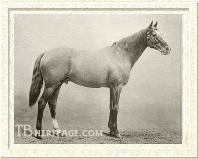
His sire, Carbine

His dam, Maid of the Mint
| |
On the surface, Spearmint had a fine pedigree, his sire Carbine, having been the greatest racehorse ever seen in Australia to that time, while his dam was a daughter of Grand Prix de Paris champion Minting. But in actuality, the pedigree of Spearmint was not a strong one.
Carbine, by Musket out of Mersey by Knowsley, had been unplaced just once in his forty-three lifetime starts, his greatest achievement being to win the Melbourne Cup under 145 pounds over 38 opponents in course record time. As a stallion in Australia, Carbine had been quite successful, siring classic winners Wallace, Amberite, Carbineer, and major stakes performers La Carabine, Flintlock, and Mural. After his exportation to Great Britain, Carbine was not as successful, his best British representative prior to Spearmint being the durable gelding Powder Puff, twice winner of the Cumberland Plate.
Maid of the Mint, was unraced. She had plenty of class on her paternal side. Her sire, Minting, was impeccably bred, being by Stockwell's Triple Crown winning son Lord Lyon, and out of the fine producer Mint Sauce, a daughter of Young Melbourne. In addition to Minting, Mint Sauce produced the classic-winning full siblings Minthe (One Thousand Guineas) and The Lambkin (St. Leger).
|
The female line of Maid of the Mint, was weak. Her dam, Warble, was a winner and had produced Cesarewitch Handicap winner Wargrave. The next dam, Cotornix, was also a minor winner, as was her dam, Fravolina. None of the first four dams of Maid of the Mint produced anything of class with the exception of Wargrave. Not until Preserve, the fifth dam of Maid of the Mint, was reached, did the family show exceptional class. Preserve, had captured the One Thousand Guineas and was a full sister to St. Leger winner Mango. Goodwood Cup winner Speculum was a member of this family, as was the champion filly Lady Elizabeth. But as the saying goes, it was a long time between drinks from the time of Speculum and Lady Elizabeth to the emergence of Spearmint.
Spearmint was included in the lot of nine yearlings sold by Sledmere in autumn of 1904. Major Eustace Loder, currently enjoying the brilliant two-year-old campaign of Pretty Polly, inspected the Sledmere yearlings with his stud manager, Noble Johnson, and decided to bid on Spearmint. The colt was knocked down to Loder at the sale for only 300 guineas, the lowest price of the Sledmere yearlings, which averaged approximately 1200 guineas.
Spearmint on the Turf
Spearmint was sent to trainer Peter Purcell Gilpin, whose yard was located at Clarehaven Lodge, Newmarket. The new acquisition thus became a stablemate of Pretty Polly, though for the next two years, Spearmint lived in her shadow. An illness shortly after his arrival at Newmarket delayed his training and racing debut for several months, and his two-year-old campaign was as abbreviated one as a consequence.
Spearmint started only three times as a juvenile. In his racecourse debut, the Great Foal Plate at Lingfield, he won by a head. Spearmint was unable to handle the blazingly fast Black Arrow in his next start at Derby, and ran second by three lengths. In his final race that season, a handicap at Newmarket, Spearmint finished unplaced.
Over the winter, it was decided Spearmint would not be a Derby contender. That role was slated for the stable's brilliant filly Flair, a beautifully bred daughter of St. Frusquin--Glare, by Ayrshire. Spearmint instead was pointed for the Grand Prix de Paris, a race not won by an English horse since Spearmint's grandsire Minting in 1886. Being by a great stayer in Carbine, it was the belief of Loder and Gilpin that Spearmint would relish the two mile distance of the Grand Prix, and he would have the luxury of more training time, since the French race would not be run until the end of June.
Plans changed less than a month before the Derby. Flair had convincingly captured the One Thousand Guineas, but suffered an injury while training three weeks before the Derby. Suddenly, Spearmint was thrust in the role of Derby representative for the Gilpin stable. Since he had been training forwardly for the Grand Prix, not much extra work was needed to get him ready for the Derby. Two works sufficed, but it was the quality of his workmates that made them extremely significant, for Spearmint was pitted against Pretty Polly and Hammerkop. That Spearmint beat Pretty Polly over 1-1/2 miles in one of the gallops showed he was in the best possible form, and set him up as the favorite for the Epsom classic.
|
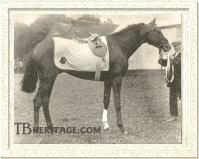
Spearmint at Epsom
| |
The race itself was somewhat anti-climactic, for Spearmint, with Danny Maher in the irons, won quite easily by 1-1/2 lengths, with Picton second and Troutbeck two lengths farther back. Spearmint's time of 2:36 4/5 was a record for the race. To illustrate just how far Spearmint had progressed since his two-year-old days, the Coronation Cup was won the next day by stablemate Pretty Polly in exactly the same time. The colt who had been unable to finish in the money in a small handicap at Newmarket the previous autumn was now a Derby winner capable of taking the measure of one of the greatest performers the British turf had ever seen, Pretty Polly, in a strong gallop and then posting a time commensurate with hers over the same course and distance in races held only twenty-four hours apart.
|
Spearmint was kept in his Grand Prix de Paris engagement, and in the race, with Bernard Dillon in the saddle, Spearmint led from start to finish of the two mile race, beating the good French colt Brisecoeur by half a length.
Spearmint never ran again. The colt's legs, always somewhat delicate, finally gave way. Though he was kept in training for another year, he could not be got sound enough to run, and he was retired to the Old Connell Stud division of his owner's Eyrefield Lodge Stud in Ireland.
What Spearmint could have accomplished on the racecourse had he remained sound can only be conjectured. His performances in the Derby and Grand Prix showed he was a very versatile horse. He had the stamina to win a two mile race from beginning to end and the speed to set a record in the Derby.
Spearmint in the Stud
At stud, Spearmint came up with classic winners in three countries -- Great Britain, Ireland, and the United States -- and his daughters proved distinguished producers. While the average distance of races won by his offspring was 10 -1/2 furlongs, he also got a significant number of speedy juvenile winners. The offspring of his sons and daughters were classic winners, and many were stout winners of such races as the Melbourne Cup, the Doncaster Cup, the Prix de l'Arc de Triomphe, and other distance events.
SPION KOP, foaled in 1917, was bred by Major Giles Loder, who had inherited Eyrefield Lodge Stud upon the death of his uncle Major Eustace Loder in 1914. Major Loder bred Spearmint with the Gallinule mare Hammerkop, a tough racemare in her day, numbering the Cesarewitch Handicap and Yorkshire Oaks among her victories. But as a broodmare she had not yet produced a winner -- until she foaled Spion Kop at the age of seventeen. As it turned out, Spion Kop was her only winner. |
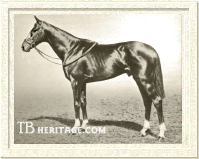
Spion Kop
| |
A strong, handsome bay colt with a blaze and four white feet, Spion Kop went through his juvenile campaign a maiden in six starts, with five second place finishes. Like Pretty Polly and Spearmint, Spion Kop was trained by Peter Purcell Gilpin at Newmarket, and Gilpin firmly believed Spion Kop would mature at three well enough to be a classics contender. When Spion Kop won his first race as a three-year-old at Ripon in easy fashion, the stable became convinced he had a good chance of performing well in the Derby. Despite a poor gallop shortly before the race in which he trailed three stablemates, and despite going off at long odds, Spion Kop turned in a victorious run at Epsom. Among those behind him were Two Thousand Guineas champion and Derby favorite Tetratema and Abbots Trace. Spion Kop set a new record for the race, 2:34.8 seconds. |
However, the Derby proved to be the pinnacle of his career. Spion Kop could not emulate his sire by taking the Grand Prix de Paris, as he ran unplaced, then lost by a head to Abbots Trace in a race at Derby, unplaced to Caligula in the St. Leger and unplaced in the Champion Stakes. At four, Spion Kop was out twice, in the Coronation Cup and the Ascot Gold Cup, and lost both times.
Retired to Loder's Old Connell Stud, Spion Kop became a respectable stallion. His runners were primarily high class stayers. Spion Kop sired a Derby winner in Felstead; Kopi, a winner of the Irish Derby; Bongrace, a winner of the Doncaster Cup and Jockey Club Cup and later the dam of the classics-placed filly Ribbon; The Bastard, later renamed The Buzzard, winner of the Yorkshire Cup and later a leading sire in Australia, where he came up with two winners of the Melbourne Cup; and the Irish St. Leger-winning full brothers Hill Song and Battle Song.
Spion Kop's Derby-winning son Felstead was unable to keep the male line going, but did come up with two extraordinary fillies--Rockfel, victress in the One Thousand Guineas, Oaks, and Champion Stakes; and Steady Aim, also an Oaks winner. Rockfel, despite an early death, became the dam of the Hyperion colt Rockefella, a decent enough sire in his own right, but noted chiefly as the broodmare sire of leading stallion Sharpen Up.
|
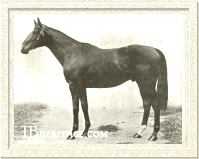
Johren
| |
JOHREN, foaled in 1915, was bred by Harry Payne Whitney in England and imported to the United States as a yearling. Whitney had a practice of sending some of his mares which were stabled at Newmarket to English and French stallions. These mares were usually American-bred fillies sent to England to race, or English-breds which he purchased. Occasionally, Whitney shipped mares overseas to be covered by a particular stallion, though this practice was largely abandoned with the advent of the World War.
Johren was named for a German saloon keeper on Long Island. Johren was out of the British mare Mineola, by Meddler.
|
Johren was a slow-developing colt, being unraced at two, and unable to break his maiden until his tenth start. Walter Vosburgh described him as a "clumsy, loose-jointed, underdeveloped creature," while trainer James Rowe despaired that "...he can neither gallop, canter, nor walk."
When Johren finally matured, he became the best three-year-old in the country, capturing the Latonia Derby, Belmont Stakes, Huron Handicap, Saratoga Cup (in which he defeated Roamer), and the Lawrence Realization. Unfortunately, Johren was not a success at stud.
Spearmint was mated multiple times with Pretty Polly and some of her daughters. Spearmint's son out of Pretty Polly, named POLYGONUM, was a minor winner that died as a three-year-old. A full sister, BABY POLLY, was not much account on the racecourse, but became a fairly decent broodmare whose family is still producing winners. |
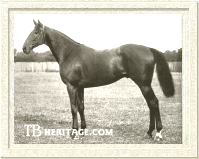
Spike Island
| |
SPIKE ISLAND, foaled in 1919, was Spearmint's son out of Pretty Polly's daughter Molly Desmond, by Desmond. Spike Island captured the Irish Two Thousand Guineas and the Irish Derby. He was not a tremendous sire, but came up with a champion filly when he was mated to the Italian mare Delleana. This mare was a champion in her own right, and was by Clarissimus out of Duccia di Buoninsegna, a granddaughter of Pretty Polly. The resultant filly, named Dossa Dossi, captured the Italian One Thousand Guineas and Italian Oaks for her breeder, Federico Tesio, and late in life, became dam of the Polish classic winner De Corte. Spike Island was later exported to Argentina for stud duty, but did not leave a lasting legacy in either Great Britain or the southern hemisphere.
|
A full sister to Spike Island was the non-winning filly LADY MAUREEN. She was sold by Major Loder to the Rothschild family, and became a producer for them at their stud, Haras de Meautry, in France. There, she founded an important family, which over the generations has included the likes of Italian classic winner Macherio and French champion and major sire Luthier.
SPELTHORNE, foaled in 1922, was a product of a mating with Pretty Polly's daughter Dutch Mary, making him a half-brother to Duccia di Buoninsegna. Spelthorne captured the Irish St. Leger. He was not a success at stud, either in Britain or later in Australia. |
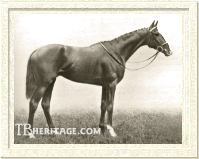
Royal Lancer
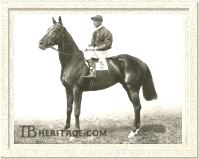
Zionist
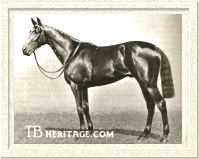
Telephus
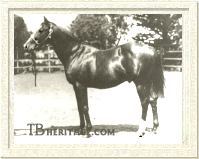
Cyklon

Chicle
| |
ROYAL LANCER, foaled in 1919, was out of the White Eagle mare Royal Favour. Royal Lancer captured both English and the Irish St. Leger. Royal Lancer's victory in the Irish race, the same year Spike Island took the first two legs of the Irish Triple Crown, gave Spearmint a sweep of the Irish classic races that season. As a stallion, Royal Lancer was purchased by Alan Gibbons of the Bridgewater Stud, South Africa. Royal Lancer while still in England came up with Good Citizen, a horse which later became a leading sire in Puerto Rico.
ZIONIST was foaled in 1922 and was out of the Roi Herode mare Judea. Owned by the Aga Khan, Zionist was a crack two-year-old, winning the Dewhurst Stakes. At three, he finished second to Manna in the Derby, but followed that up with a victory in its Irish counterpart.
Zionist was sold by the Aga Khan to Baron Brugmann as a replacement for the deceased Soranus. Zionist stood in France and came up with several good winners, including Pomme d'Api, Scolopax, and Mas d'Antibes, winner of the Prix Thomas Byron.
A younger full brother to Zionist, MONEY MAKER also won the Dewhurst Stakes. Money Maker was sent to Yugoslavia for stallion duty and became a leading sire there.
Like Zionist and Money Maker, TELEPHUS (out of Chere Reine, by Florizel II), was another winner of the Dewhurst Stakes, proving that Spearmint was able to sire some first rate speed runners despite his stamina-laden pedigree. In fact, when Spearmint died, he had sired 93 winners, 41 of which had been winners as juveniles. This statistic meshed with what Spearmint had shown on the racetrack--stamina mixed with some high class speed.
Several sons of Spearmint were exported to Australia and New Zealand. The ones which were successful included: CATMINT (out of Red Lily, by Persimmon), a fairly decent sire in New Zealand and CYKLON (out of Cyanean, by Cyllene), a stakes winner in Australia and sire of several major stakes winners in that country, including Trivalve, winner of the AJC Derby, VRC Victoria Derby, VRC St. Leger, and the Melbourne Cup. SPEARHEAD (out of Baroness La Fleche, by Ladas), was the best Spearmint sire son in Australia, siring classic-winning filly Lineage, dual classic winner and Melbourne Cup champion Spearfelt, and Cox Stakes winners Battery Gold and The Dimmer.
Perhaps the most important son of Spearmint from a breeding standpoint was CHICLE. Like Johren, Chicle was bred by Harry Payne Whitney. Chicle was foaled in France in 1913 and brought to the United States as a yearling, just before the hostilities of World War War I started. Chicle's dam was the Hamburg mare Lady Hamburg, who later produced the colt Dis Donc for Whitney.
|
Chicle was slow to develop, and did not reach his best form until late in his two-year-old season. Trained by James Rowe, he beat a good field in the Champagne Stakes (7 furlongs). His biggest win at three came in the Brooklyn Derby, now known as the Dwyer Stakes. Chicle's career was somewhat hampered by a nasty temperament, and later on in life, he had a reputation for viciousness.
In Whitney's stud Chicle had access to broodmares with the blood of Broomstick, Peter Pan, Whisk Broom II, and Pennant, which helped send him to the top of the American sire list in 1929, and contributed to his enduring legacy as a valuable sire broodmares.
Some of the most important runners by Chicle included: Cherry Pie, winner of several major stakes, including the Jerome Handicap, and placed in such events as the Suburban and Manhattan Handicaps; Gadfly,winner of the Pimlico Oaks; Goose Egg, winner of the Spinaway Stakes; and Edelweiss, winner of the Coaching Club American Oaks. From the Broomstick daughter, Flying Witch, he got two champion two year olds: Mother Goose, a brilliant filly which beat the colts in the Futurity Stakes, and Whichone, whose ten wins from fourteen starts included the Futurity Stakes, Champagne Stakes, Saratoga Special, Whitney Stakes, Withers Stakes, and Miller Stakes.
Daughters of Chicle proved outstanding producers, some of the runners from his daughters included Kentucky Derby and Belmont Stakes champion Shut Out; Hopeful Stakes winner Boojum (from Whitney-bred stakes-winning filly Elf); multiple stakes winning juvenile colt Dice; major stakes winning filly and influential broodmare Blue Delight; and Incandescent, second dam of Triple Crown winner Assault. Chicle died in 1939.
Perhaps not unsurprisingly, Spearmint's blood also emerged as prominent in jumpers. His son, STEEL POINT (1923), out of the Troutbeck staying daughter, Laragh, was a leading sire of National Hunt horses in the late 40's and early '50s, with twenty different steeplechase winners in the 1949-50 season. His best son was Freebooter, winner of the Grand National at Aintree in 1950. Another top National Hunt sire by Spearmint was WAVETOP (1925), out of Wavinta, by Walmsgate (sire of Jerry M.); one of his sons, Knight's Crest, won the Irish Grand National. Spearmint's son, Spion Kop, also had an influence on jumpers: his son, Landscape Hill, got two very good jumpers in Cromwell and Monaveen.
As good as these sons of Spearmint were, his male line eventually petered out, both in Great Britain and the United States. It was left to the daughters of Spearmint to perpetuate his genes to future generations. Two of his daughters in particular, Catnip and Plucky Liege, exerted tremendous influence.
Spearmint's Daughters
CATNIP, foaled in 1910, was bred by Major Eustace Loder and was out of the American-bred Sibola, by The Sailor Prince. Sibola had been a smart race filly, capturing the One Thousand Guineas, and running second to Musa in the 1899 Epsom Oaks. Unfortunately, Catnip inherited little of the talent of her parents. She was a small, weedy youngster, capable of winning only the Gosforth Nursery Handicap, a £100, 8 furlong race at Newcastle in her juvenile year of nine starts; at age three she ran once, unplaced. At age five, she was bred to Pretty Polly's brother, Cock-a-Hoop, and consigned to the Newmarket December sale of 1915. Bloodstock prices were depressed during this time of war, and with her strong dose of American blood, which British breeders had no desire for, Catnip was one of the least attractive lots in the sale.
One man saw some potential in her and landed her for the incredibly low price of 75 guineas. That man was Italian breeder Federico Tesio, master of Dormello Stud, the breeding operation he was developing near Lake Maggiore in the Lombardy region of Italy. Transplanted to this sunny climate, Catnip developed into one of the foundation mares of Tesio's breeding program.
She bred four important foals: Nesiotes, by Hurry On, a winner of fifteen races and a good Italian sire; Nomellina, by St. Amant, a filly which won eight races; and Nera di Bicci, a Tracery filly who also won eight races and was later an oustanding broodmare for Tesio, producing two Italian classic winners and influential daughters. But the fourth foal was Catnip's most significant, for this was Nogara, a filly by Havresac II.
Nogara was a brilliant performer on the racetrack, winning the Criterium Nazionale as a two-year-old and the Italian One Thousand Guineas and Italian Two Thousand Guineas the following season. As a broodmare, Nogara was even more successful than her mother, for her foals included the unbeaten champion Nearco; Niccolo dell'Arca, winner of the Italian Derby and Gran Premio di Milano; Nakamuro, placed in the Italian Derby; Niccolo dell'Arezzo, placed in the Italian St. Leger; Nervesa, victress in the Italian Oaks; and Naucide, an Italian champion at both two and three. |
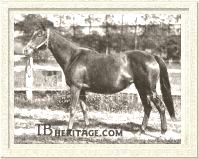
Plucky Liege
| |
As important as Catnip proved to be, Spearmint sired another daughter of even greater renown. This was PLUCKY LIEGE. She was born in 1912, and combined two prominent bloodlines of the Duke of Portland's Welbeck Abbey Stud -- those of Carbine and St. Simon. The dam of Plucky Liege was the St. Simon daughter Concertina, a member of the prolific Miss Agnes family. Plucky Liege was bred by Lord Michelham, who had acquired Concertina from the Duke's stud.
Plucky Liege was a precocious juvenile, winning four of her six starts. She could not replicate that form at three, running unplaced in the classic One Thousand Guineas and third to Friar Marcus in the Queensbury Handicap, her best performance of the season.
|
Lord Michelham chose not to keep Plucky Liege for his own breeding purposes and sold her to his secretary, Jefferson Davis Cohn. The latter was an enthusiastic breeder, and leased Haras du Bois Roussel in France where he stood his stallion, Teddy. It was here that Cohn sent his new broodmare purchase. In Cohn's stud, Plucky Liege became one of the most influential mares of the 20th Century. Her foals included the full brothers Sir Gallahad III and Bull Dog, both by Teddy.
Sir Gallahad III's biggest victory came in the classic Prix de Poulains, France's version of the Two Thousand Guineas. He was purchased by a syndicate headed by Arthur Boyd Hancock and exported to the United Sates, where he stood his entire career at Claiborne Farm. Sir Gallahad III proved an immediate success, siring American Triple Crown champion Gallant Fox in his very first crop. During his career, he led the American sire list twice and the broodmare sire list twelve times.
Bull Dog, seven years the junior of Sir Gallahad III, was not as talented on the racetrack as his older brother had been, but did win a couple of stakes in France. He, too, wound up in America, purchased by Charles Schaffer, master of Coldstream Stud near Lexington. Bull Dog led the American sire list once and the broodmare sire list four times and was renowned as the sire of Calumet Farm's mighty stallion Bull Lea.
Plucky Liege was also the dam of Admiral Drake, winner of the Grand Prix de Paris and a good sire; Bois Roussel, winner of the Epsom Derby and also an important sire, with his male line including Migoli and Tehran and their sons, Gallant Man and Tulyar.
Plucky Liege's daughters by Teddy, Marguerite de Valois and Noor Jahan, were each winners and each founded branches of their dam's family which are still actively producing classic winners and major stakes winners to the present. Plucky Liege died at the age of 25 in 1937. With four major siring sons and two important producing daughters, this daughter of Spearmint made sure her sire was present in both European and American pedigrees for many years. |
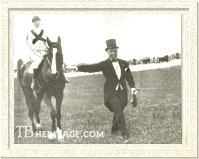
Fausta
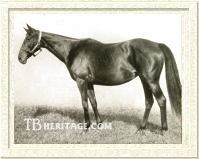
Silesia
| |
Another Spearmint daughter purchased by Tesio was FAUSTA (1911), from Madree, by Triple Crown winner Flying Fox. Bred by Signor Centurini of Rome, her dam, Madress, also produced Sigma, who founded a great classic Italian family. Fausta was bought as a yearling by Tesio, and became the best of her generation in Italy, colt or filly, winning nine races and placing four times in fourteen starts, including the Italian Derby and Oaks. As a producer, she came up with three Italian Derby winners, all brothers by Signorino, Michelangelo, Melozzo da Forli, and Meissonier. She also bred Michelozza, dam of Oaks winner Michela and Maratta Faustina, dam of the Premio d'Italia winner Moroni, later a sire of some note.
One of the mares to visit Spearmint in his first stud season was Alfred Cox's Galopin mare Galicia. The result of the mating was a filly which was called SILESIA. She only ran in top company, but was unplaced as a juvenile, and at age three could only place three times in eight starts -- second in the Knowsley Dinner Stakes and the Newmarket Oaks (out of three runners in both instances), and third in the Lennox Plate at Hurst. She earned a place among her owner's broodmares due to the exploits of her older half brothers, Bayardo and Lemberg, both classic winners. She did not disappoint.
|
Her 1915 filly by Beppo, named My Dear, emerged a victress in the Dewhurst Stakes at two and the Oaks Stakes and Champion Stakes at three. My Dear also ran second in the Two Thousand Guineas and the St. Leger. Silesia produced Ciceronnetta, a Cicero filly in 1916; she became the dam of the brilliant, short-lived Beppo son Picaroon, winner of the Middle Park Stakes at two and the Champion Stakes at three.
SIRENIA, the dam of stakes winner Cellini and One Thousand Guineas winner Electra, was one of the mares Major Eustace Loder bred to Spearmint in his first stud season. The Spearmint filly, named SOURABAYA, never made a mark as a runner and was eventually acquired by Ludwig Neumann. Sent by her new owner to the court of the stayer Bachelor's Double, Sourabaya became the dam of Comrade, winner of the Grand Prix de Paris and the inaugural running of the Prix de l'Arc de Triomphe.
BATHING GIRL, out of Summer Girl, by Sundridge, was a foal of 1915. Bathing Girl never raced, but even so, Walter Jeffords paid $4,000 for the mare, in foal to Swynford's moderate full brother Harry of Hereford. Jeffords purchased Bathing Girl as a prospective mate for Man o' War, standing his first stud season in 1921. Upon her arrival in the United States, Bathing Girl dropped her foal, a filly named Annette K., in honor of the famed Australian swimmer Annette Kellerman.
Annette K., unplaced in her only start, was purchased by Samuel Riddle, owner of Man o' War, and became a successful broodmare for him. Among her produce was the high class stakes winner War Glory, winners Booming Guns, Fleet Admiral, and Warrior Queen, and producers Marching Along and Brushup, the latter dam of American Triple Crown champion War Admiral.
For Jeffords, Bathing Girl also foaled the winning Man o' War filly Seaplane, destined to become the second dam of Eight Thirty, winner of several major stakes including the Travers Stakes, Metropolitan Handicap, and Suburban Handicap and later sire of 44 stakes winners.
POLLY PEACHUM, out of the Gallinule mare Lindoiya, was a foal of 1913. She became the dam of Pot au Feu, winner of the Prix du Jockey Club for the Aga Khan in 1924.
SEAWEED, out of the Ayrshire mare Seadune, was foaled in 1916. She was exported to France and there produced two exceptional runners -- the full siblings Hotweed and Brulette, both by Brûleur. Brulette was brought to England, where she captured the Epsom Oaks and the Goodwood Cup. In France, she was a winner of the Prix du Cadran. Her brother, Hotweed, captured the Prix du Jockey Club at three and placed in the Ascot Gold Cup and Prix de l'Arc de Triomphe at four.
FLYING SPEAR, produced from the Galloping Lad mare Gallop Along, was a foal of 1916. She was a smart performer on the track, accounting for the Park Hill Stakes and the Coronation Stakes as a three-year-old. As a broodmare, she produced the Swynford colt Lancegaye, who ran second to Coronach in the Epsom Derby. Lancegaye was only a moderate stallion, his main claim to fame came as the sire of American champion Cavalcade, imported to the United States in utero and foaled in New Jersey.
Spearmint died of colic on June 24, 1924. He was twenty-one years old. He was buried near the main residence at Eyrefield Lodge, where, in later years, his son Spion Kop and one time stablemate Pretty Polly were also interred.
--Liz Martiniak
|
|
|
|

